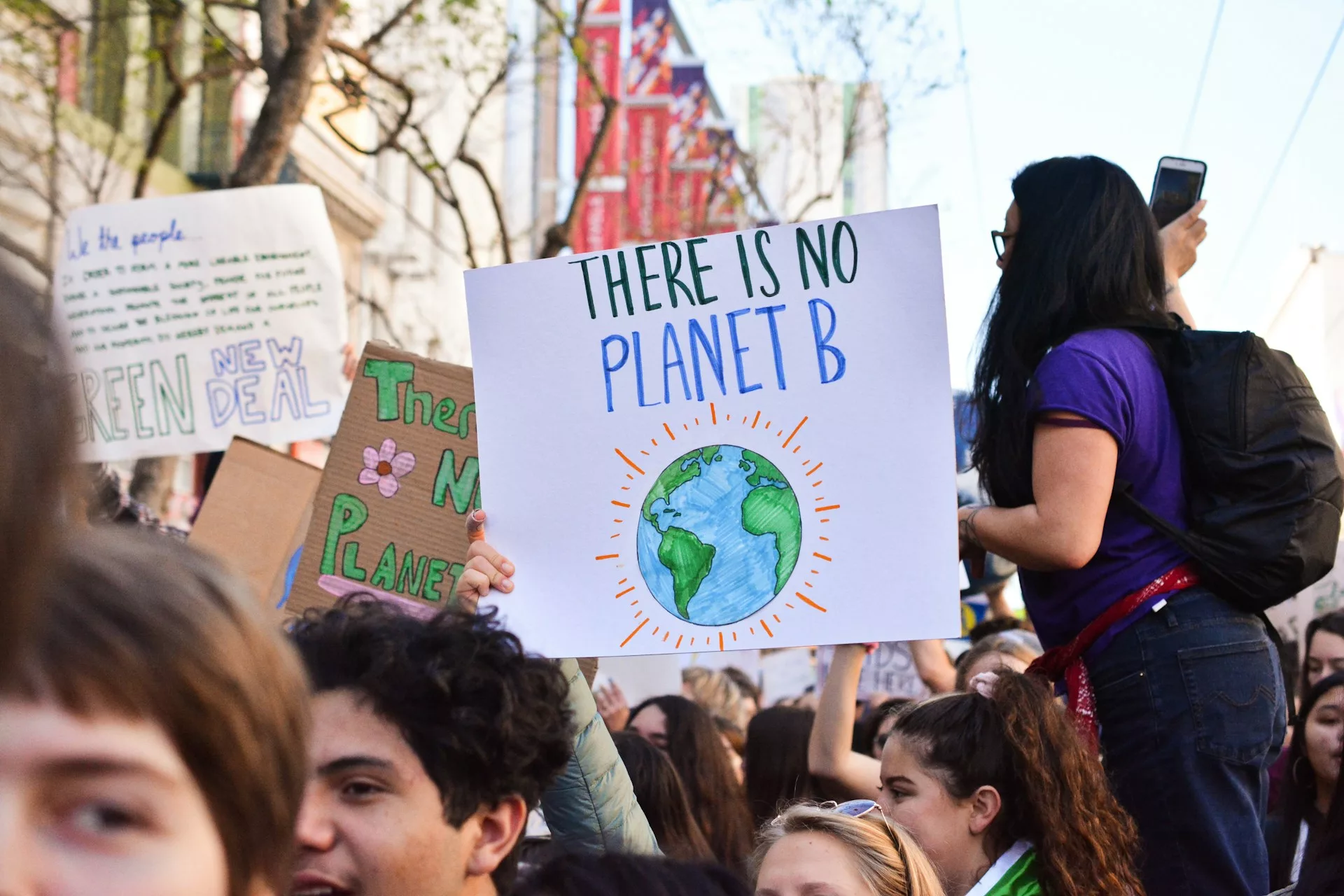In 2015, the Paris Agreement emphasised the need to limit global warming to 1.5°C above pre-industrial levels. As this limit will likely be breached, we need technology now to mitigate the inevitable damage caused—AI may be the answer. Photo credit: Li-An Lim via Unsplash
Human-induced climate change is one of the greatest and most pervasive threats to the natural environment that the world has ever faced. Some of its devastating effects include hotter temperatures, more severe storms, and rising oceans. There is a rapidly closing window of opportunity to prevent irreversible damage and secure a sustainable future—and we are now at a crucial tipping point. Therefore, it is vital that we use all the tools at our disposal to combat and mitigate the effects of climate change. As our technological world becomes more advanced and we witness the meteoric rise of artificial intelligence (AI), we should ask ourselves how developments in AI could help or hinder us in the fight against a rapidly warming globe.
There is a rapidly closing window of opportunity to prevent irreversible damage and secure a sustainable future — and we are now at a crucial tipping point.
In 1979, scientists from 50 nations met in Geneva for the First World Climate Conference, where they agreed that alarming trends in global climate made it urgently necessary to act. Fast-forward 45 years, and despite regular global climate conferences, we have largely failed to address this problem. As a result, the situation has worsened, with global carbon dioxide (CO2) emissions for 2022 increasing by 1.5% relative to 2021 and 2% relative to pre-pandemic 2019.
These 2022 emissions consumed a significant proportion of the remaining “carbon budget” to limit warming to 1.5°C (above pre-industrial levels), a target set out in the 2015 Paris Agreement. Further warming above this threshold risks unleashing even more serious climate impacts, such as more frequent and severe heatwaves, droughts, and rainfall. Worryingly, the 2023 report by the Intergovernmental Panel on Climate Change (IPCC) lays out in stark terms how close the world is to missing the 1.5°C target.
What is artificial intelligence (AI)?
According to David Jenson, coordinator of the Digital Transformation section within the United Nations Environment Program (UNEP), ‘AI refers to systems or machines that perform tasks that typically require human intelligence, and can iteratively improve themselves over time, based on the information they collect’.
The capabilities of AI truly entered the public eye in late 2022 after the release of OpenAI’s ChatGPT. By now, you have probably used ChatGPT to write emails, plan your meals, or re-write your homework assignment in the style of Obama. However, the capabilities of AI stretch far beyond this, showing the potential to transform both industry and society. The capabilities of AI to address key environmental challenges, particularly through improved data analysis and environmental modelling, are discussed below.
How can artificial intelligence help us resolve the global climate emergency?
Continuous, real-time monitoring of different aspects of the environment allows us to quantify our impact accurately and enables decision-making that is guided by facts instead of prejudices or instincts. AI analytics can process large volumes of data and identify complex patterns and insights, improving human interaction with large data sets that would otherwise appear impenetrable.
Furthermore, AI can handle both “structured” (organised in spreadsheets) and “unstructured” (text, images, audio, video) data, integrating information from these sources to give a holistic picture. These capabilities not only enable reliable real-time environmental monitoring but also aid in the prediction of outcomes arising from different responses. Hence, AI analytics vastly enhance our ability to optimise decision-making with respect to climate change mitigation through the visualisation and processing of complex, multifaceted data. For example, UNEP is leading a series of initiatives that leverage AI’s capabilities to analyse complex datasets.
…AI analytics vastly enhance our ability to optimise decision-making with respect to climate change mitigation…
In particular, UNEP’s International Methane Emissions Observatory (IMEO) focuses on monitoring methane emissions from the energy sector. Methane is responsible for around 30% of the current rise in global temperatures, so reducing methane emissions is imperative in the fight against climate change. IMEO uses AI to integrate methane emissions data from many different sources, including data from industry (via the Oil and Gas Methane Partnership 2.0), scientific studies, satellite sensing, and national inventories. Integration of these data sets is crucial to fill the gaps that exist in current datasets, producing a public record of global methane emissions at an unparalleled level of accuracy. And that’s not all—AI can also be used to track air quality and monitor bio-diversity, which is essential to inform policies and actions that mitigate the impacts of climate change on ecosystems.
The effects of climate change represent a serious threat to cities within emerging economies, such as Lagos (Nigeria). Lagos is situated near the coast, which makes it particularly susceptible to rising sea levels, extreme temperatures, and increased rainfall. Since 2021, the Boston Consulting Group (BCG) has been using AI to illustrate the risks of climate change to the city. BCG’s AI system mapped out the potential climate outcomes geographically, generating a “climate risk index”. For sea-level rise, this index considers flood intensity, size of the population affected and vulnerable, and economic impact in order to accurately identify the areas of the city that are most at risk. This quantitative and region-specific data not only provides a basis for making logical decisions to safeguard the most threatened areas of the city but also provides a clear illustration of the disastrous impacts of climate inaction, which could pressure authorities to adopt mitigation policies.
Additionally, AI could play a role in the development of autonomous vehicles, where AI-led route optimisation and eco-driving algorithms could reduce fuel consumption and decrease transport-related greenhouse gas emissions. AI advances could also be crucial in developing “smart cities”, where local authorities can track the energy use of their companies and citizens. This would allow for the optimal placement of renewable energy generation facilities and reveal the areas of high energy waste so that effective conservation measures could be implemented.
But what’s the catch?
However, it is important to consider how this powerful tool could turn on us. And no, I don’t mean a Terminator-style world takeover, but rather the potential environmentally damaging effects of developing and widely implementing AI systems.
Firstly, it is surprising how much energy is required to train popular large AI models. A recent study by Strubell et al. (2019) estimated that the training process could emit over 300,000 kg (600,000 lbs) of carbon dioxide emissions — that’s around five times the lifetime emissions of a car!
In addition, the rise of AI could lead to an increase in hardware manufacture to support the use of AI software (portable electronics, data servers, cables, etc.). This could be environmentally damaging due to the energy-intensive extraction of lithium and cobalt, which are elements required to make batteries for portable electronics or electric vehicles. These materials must be transported to factories to produce components, before being transported to AI developers and users. Currently, most of the energy for the extraction and transport of these raw materials comes from fossil fuels, with significant associated CO2 emissions. Moreover, integrating of AI into manufacturing processes (“smart manufacturing”) will likely improve overall efficiency and output, potentially increasing demand for raw materials.
And the problems do not end there…“e-waste” (which refers to discarded electronic appliances, like phones and computers) produced as a result of AI development or AI-enhanced manufacturing poses a serious environmental challenge. Of the 53.9 Mt of e-waste generated in 2019, just 9.3 Mt (17%) was documented as collected or recycled. You can probably guess where the rest ended up. This is particularly concerning given that e-waste contains hazardous chemicals (such as lead, mercury, and cadmium) that could contaminate soil and water supplies, endangering human health.
It is, therefore, essential to develop efficient e-waste recycling systems and force manufacturers to consider the circularity and recyclability of their products in the initial design. There is also an opportunity to mine valuable materials from e-waste. In the case of gold, mining discarded electronics has been shown to reduce emissions by 80% for each unit of gold compared with extracting it from the ground.
Can Artificial Intelligence really help us fight climate change?
If we are not careful, the development and use of AI could be more damaging to the environment than if it had never existed at all.
AI advances show enormous potential to help us solve key environmental problems, predominantly through improved real-time environmental monitoring, which can then inform our decisions and enable us to identify the most impactful actions. However, it is important to contrast the largely indirect nature of the solutions provided with the very direct potential costs. If we are not careful, the development and use of AI could be more damaging to the environment than if it had never existed at all.
You could say we are at the dawn of an “AI arms race” in which governments, universities, and companies are all competing to make their models more accurate. However, it is crucial that sustainability comes to the forefront of policymakers’ minds, and there are many adaptations that could be put in place to reduce the negative environmental impacts of AI development. For example, the facilities housing the AI servers could be powered by renewable energy sources and located somewhere with a cool climate or underground (so less energy is spent on cooling).
Tech giants, such as Google, are already investing in data centres in Nordic countries due to their cool climate and the availability of geothermal and hydroelectric power. In addition, Microsoft is investing in nuclear energy to power its data centres and AI, intending to build next-generation “small modular reactors”. These initiatives represent a valuable first step in establishing a sustainable route for AI development.
Finally, the capability of AI to spot patterns and gain insight from large amounts of data can be used to aid environmental policymaking and governance. However, it is important to recognise that there are social concerns with using AI in this way. Decisions or conclusions drawn by algorithms may lack context or fail to account for conditions that cannot be easily parameterised. For example, CLIMSAVE (a pan-European project) developed an integrated assessment platform enabling stakeholders to explore adaptation options for reducing climate change impacts in different sectors (such as agriculture, forests, and coasts). However, users complained about the lack of different adaptation options that could be factored into and evaluated by the algorithm. Therefore, it is important that policymakers are aware of the current limitations of AI models and that AI should be used to inform decisions, rather than guide them.
AI will likely penetrate all aspects of our lives — whether we like it or not! However, it is imperative that a global, data-driven debate takes place to develop environmentally-oriented principles and legislation, enabling a future where AI contributes positively to the health of the planet.





